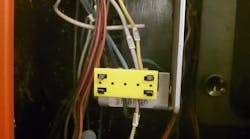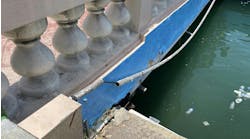How well do you know the Code? Think you can spot violations the original installer either ignored or couldn't identify? Here's your chance to moonlight as an electrical inspector and second-guess someone else's work from the safety of your living room or office. It's your turn to identify the violation.
Hint: Poor choice of color
Find the Answer
I found these power connections inside of a fire alarm panel. For some reason, the installer chose to use yellow for the grounded neutral wire. Despite the fact that a “NEUT” label was installed on this wire, this is still a violation of Sec. 200.6(A).
Insulated neutral conductors of size 6 and smaller must be identified by using a wire with a continuous white or gray outer finish. Three white or gray stripes are also permitted along the wire’s length on other than green wires. Using a yellow wire and placing a “NEUT” or “NEUTRAL” label on it is simply not permitted. While I must give credit to the installer for at least making an attempt to “identify” the neutral, he did not try hard enough to be Code compliant.
A common industry use for yellow conductors is for identification of the indicating phase C of a 480V, 3-phase system. While this is not mandatory, it is a very common practice to use brown for Phase A, orange for Phase B, and yellow for Phase C. Using yellow for the neutral could cause some very serious and dangerous confusion in the field.




